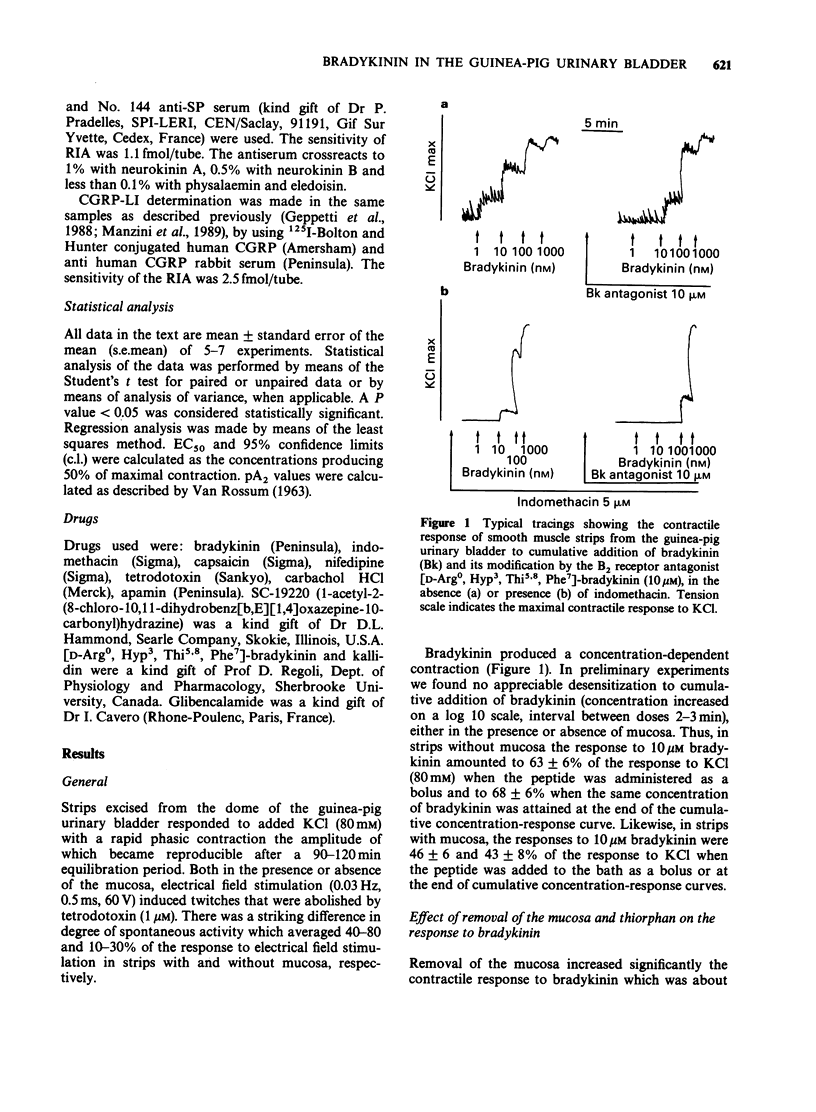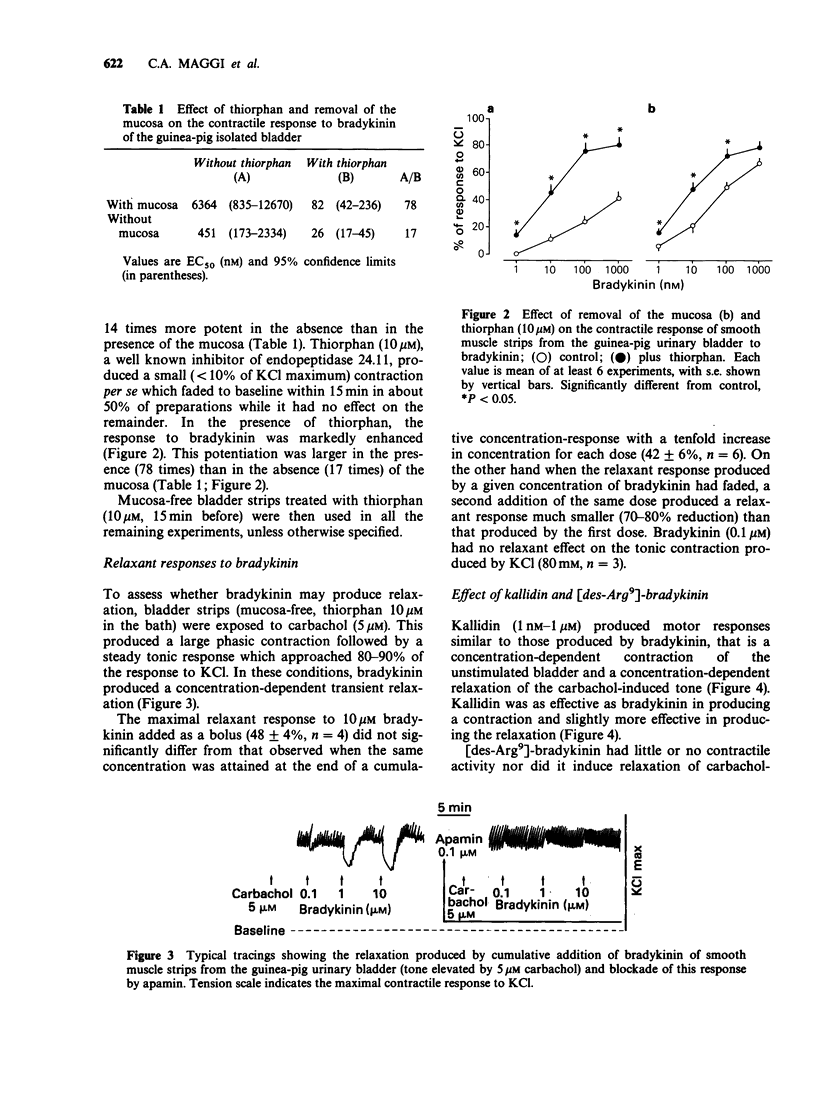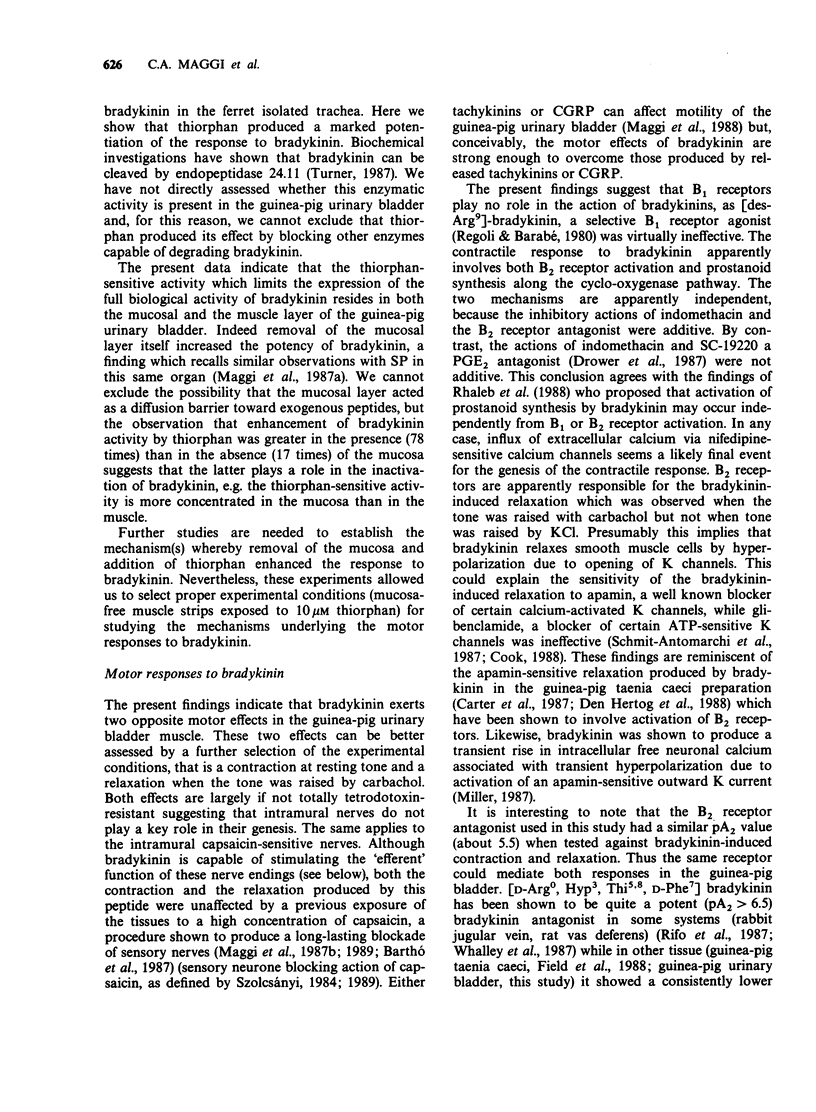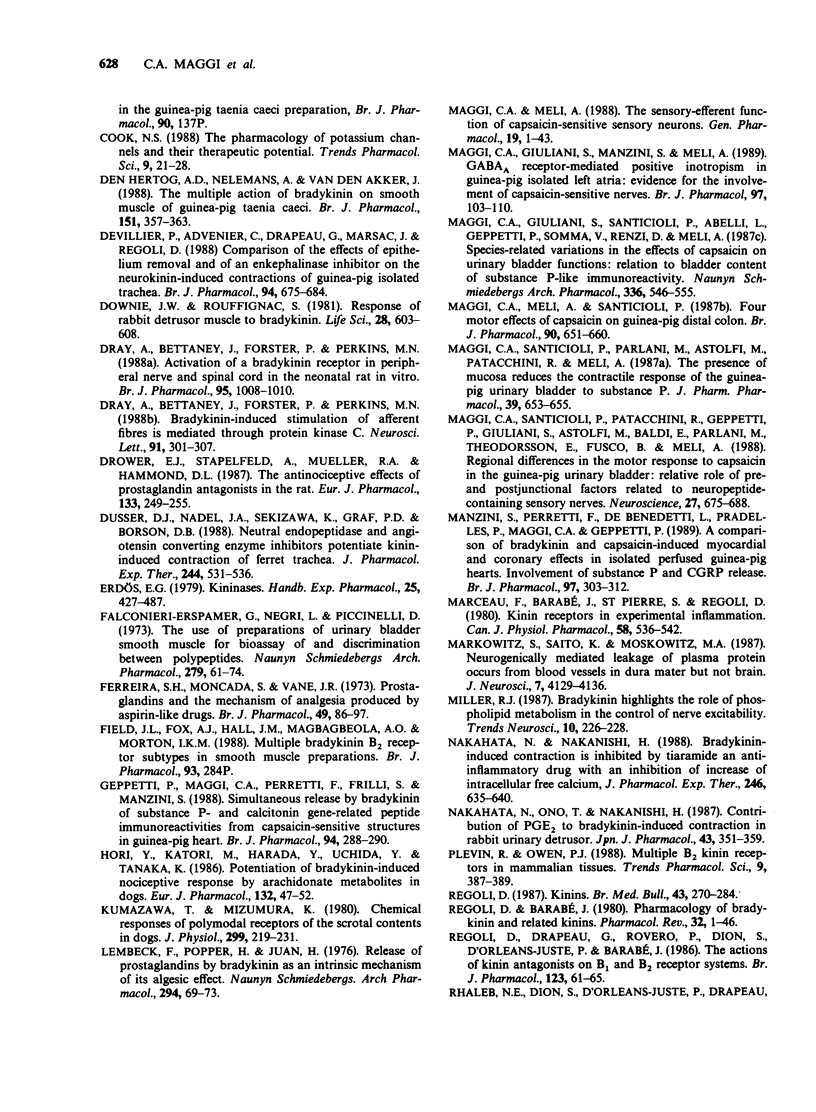Abstract
1. Bradykinin (1 nm-1 microM) produced a contraction of bladder strips excised from the dome of the guinea-pig urinary bladder, an effect which was greatly enhanced by removal of the mucosal layer or by thiorphan (10 microM). All subsequent experiments were performed in mucosa-free strips and in the presence of thiorphan. 2. In carbachol (5 microM)-contracted strips, bradykinin produced a concentration (1 nm-1 microM)-dependent transient relaxation. 3. Kallidin was slightly more potent than bradykinin in producing a contraction and a relaxation of the carbachol-induced tone. By contrast, [des-Arg9]-bradykinin, a selective B1 receptor agonist was barely effective up to 1 microM. 4. The contractile response to bradykinin was: (a) unaffected by either tetrodotoxin (1 microM), in vitro capsaicin desensitization (10 microM for 30 min) or apamin (0.1 microM); (b) antagonized by indomethacin (5 microM), the prostaglandin receptor antagonist SC-19220 (100 microM) or the B2 receptor antagonist [D-Arg0, Hyp3, Thi5,8, Phe7]-bradykinin (10 micron) and (c) almost abolished by nifedipine (1 microM). 5. The antagonism of the contractile response to bradykinin produced by indomethacin and SC-19220 was non-additive while that produced by indomethacin and the B2 receptor antagonist was additive. 6. The relaxant response to bradykinin was unaffected by tetrodotoxin, in vitro capsaicin desensitization or indomethacin but antagonized in a competitive manner by the B2 receptor antagonist. Further, this response was abolished by apamin (0.1 microM) but unaffected by glibenclamide (1 microM). 7. Bradykinin (10 microM) produced a consistent release of calcitonin gene-related peptide-like immunoreactivity (CGRP-LI) but not substance P-LI from the guinea-pig bladder muscle. CGRP-LI release by bradykinin was greatly reduced in bladders exposed to indomethacin. [des-Arg9]-bradykinin (10 microM) was ineffective. 8. We conclude that: (a) bradykinin-induced contraction involves activation of both B2 receptors and prostanoid synthesis, via distinct mechanisms which act by inducing calcium influx via nifedipine-sensitive channels; (b) bradykinin-induced relaxation involves activation of B2 receptors and opening of apamin-sensitive potassium channels; (c) bradykinin stimulates sensory nerves in this tissue largely via prostanoid production.
Full text
PDF










Selected References
These references are in PubMed. This may not be the complete list of references from this article.
- Barthó L., Pethö G., Antal A., Holzer P., Szolcsányi J. Two types of relaxation due to capsaicin in the guinea pig isolated ileum. Neurosci Lett. 1987 Oct 16;81(1-2):146–150. doi: 10.1016/0304-3940(87)90355-7. [DOI] [PubMed] [Google Scholar]
- Cook N. S. The pharmacology of potassium channels and their therapeutic potential. Trends Pharmacol Sci. 1988 Jan;9(1):21–28. doi: 10.1016/0165-6147(88)90238-6. [DOI] [PubMed] [Google Scholar]
- Den Hertog A., Nelemans A., Van den Akker J. The multiple action of bradykinin on smooth muscle of guinea-pig taenia caeci. Eur J Pharmacol. 1988 Jul 14;151(3):357–363. doi: 10.1016/0014-2999(88)90531-6. [DOI] [PubMed] [Google Scholar]
- Devillier P., Advenier C., Drapeau G., Marsac J., Regoli D. Comparison of the effects of epithelium removal and of an enkephalinase inhibitor on the neurokinin-induced contractions of guinea-pig isolated trachea. Br J Pharmacol. 1988 Jul;94(3):675–684. doi: 10.1111/j.1476-5381.1988.tb11575.x. [DOI] [PMC free article] [PubMed] [Google Scholar]
- Downie J. W., Rouffignac S. Response of rabbit detrusor muscle to bradykinin. Life Sci. 1981 Feb 9;28(6):603–608. doi: 10.1016/0024-3205(81)90123-5. [DOI] [PubMed] [Google Scholar]
- Dray A., Bettaney J., Forster P., Perkins M. N. Activation of a bradykinin receptor in peripheral nerve and spinal cord in the neonatal rat in vitro. Br J Pharmacol. 1988 Dec;95(4):1008–1010. doi: 10.1111/j.1476-5381.1988.tb11732.x. [DOI] [PMC free article] [PubMed] [Google Scholar]
- Dray A., Bettaney J., Forster P., Perkins M. N. Bradykinin-induced stimulation of afferent fibres is mediated through protein kinase C. Neurosci Lett. 1988 Sep 12;91(3):301–307. doi: 10.1016/0304-3940(88)90697-0. [DOI] [PubMed] [Google Scholar]
- Drower E. J., Stapelfeld A., Mueller R. A., Hammond D. L. The antinociceptive effects of prostaglandin antagonists in the rat. Eur J Pharmacol. 1987 Jan 20;133(3):249–256. doi: 10.1016/0014-2999(87)90020-3. [DOI] [PubMed] [Google Scholar]
- Dusser D. J., Nadel J. A., Sekizawa K., Graf P. D., Borson D. B. Neutral endopeptidase and angiotensin converting enzyme inhibitors potentiate kinin-induced contraction of ferret trachea. J Pharmacol Exp Ther. 1988 Feb;244(2):531–536. [PubMed] [Google Scholar]
- Erspamer G. F., Negri L., Piccinelli D. The use of preparations of urinary bladder smooth muscle for bioassay of and discrimination between polypeptides. Naunyn Schmiedebergs Arch Pharmacol. 1973;279(1):61–74. doi: 10.1007/BF00502068. [DOI] [PubMed] [Google Scholar]
- Ferreira S. H., Moncada S., Vane J. R. Prostaglandins and the mechanism of analgesia produced by aspirin-like drugs. Br J Pharmacol. 1973 Sep;49(1):86–97. doi: 10.1111/j.1476-5381.1973.tb08270.x. [DOI] [PMC free article] [PubMed] [Google Scholar]
- Geppetti P., Maggi C. A., Perretti F., Frilli S., Manzini S. Simultaneous release by bradykinin of substance P- and calcitonin gene-related peptide immunoreactivities from capsaicin-sensitive structures in guinea-pig heart. Br J Pharmacol. 1988 Jun;94(2):288–290. doi: 10.1111/j.1476-5381.1988.tb11528.x. [DOI] [PMC free article] [PubMed] [Google Scholar]
- Hori Y., Katori M., Harada Y., Uchida Y., Tanaka K. Potentiation of bradykinin-induced nociceptive response by arachidonate metabolites in dogs. Eur J Pharmacol. 1986 Dec 2;132(1):47–52. doi: 10.1016/0014-2999(86)90007-5. [DOI] [PubMed] [Google Scholar]
- Kumazawa T., Mizumura K. Chemical responses of polymodal receptors of the scrotal contents in dogs. J Physiol. 1980 Feb;299:219–231. doi: 10.1113/jphysiol.1980.sp013121. [DOI] [PMC free article] [PubMed] [Google Scholar]
- Lembeck F., Popper H., Juan H. Release of prostaglandins by bradykinin as an intrinsic mechanism of its algesic effect. Naunyn Schmiedebergs Arch Pharmacol. 1976 Jul;294(1):69–73. doi: 10.1007/BF00692786. [DOI] [PubMed] [Google Scholar]
- Maggi C. A., Giuliani S., Manzini S., Meli A. GABAA receptor-mediated positive inotropism in guinea-pig isolated left atria: evidence for the involvement of capsaicin-sensitive nerves. Br J Pharmacol. 1989 May;97(1):103–110. doi: 10.1111/j.1476-5381.1989.tb11929.x. [DOI] [PMC free article] [PubMed] [Google Scholar]
- Maggi C. A., Giuliani S., Santicioli P., Abelli L., Geppetti P., Somma V., Renzi D., Meli A. Species-related variations in the effects of capsaicin on urinary bladder functions: relation to bladder content of substance P-like immunoreactivity. Naunyn Schmiedebergs Arch Pharmacol. 1987 Nov;336(5):546–555. doi: 10.1007/BF00169312. [DOI] [PubMed] [Google Scholar]
- Maggi C. A., Meli A., Santicioli P. Four motor effects of capsaicin on guinea-pig distal colon. Br J Pharmacol. 1987 Apr;90(4):651–660. doi: 10.1111/j.1476-5381.1987.tb11217.x. [DOI] [PMC free article] [PubMed] [Google Scholar]
- Maggi C. A., Meli A. The sensory-efferent function of capsaicin-sensitive sensory neurons. Gen Pharmacol. 1988;19(1):1–43. doi: 10.1016/0306-3623(88)90002-x. [DOI] [PubMed] [Google Scholar]
- Maggi C. A., Santicioli P., Parlani M., Astolfi M., Patacchini R., Meli A. The presence of mucosa reduces the contractile response of the guinea-pig urinary bladder to substance P. J Pharm Pharmacol. 1987 Aug;39(8):653–655. doi: 10.1111/j.2042-7158.1987.tb03447.x. [DOI] [PubMed] [Google Scholar]
- Maggi C. A., Santicioli P., Patacchini R., Geppetti P., Giuliani S., Astolfi G. M., Baldi E., Parlani M., Theodorsson E., Fusco B. Regional differences in the motor response to capsaicin in the guinea-pig urinary bladder: relative role of pre- and postjunctional factors related to neuropeptide-containing sensory nerves. Neuroscience. 1988 Nov;27(2):675–688. doi: 10.1016/0306-4522(88)90297-7. [DOI] [PubMed] [Google Scholar]
- Manzini S., Perretti F., De Benedetti L., Pradelles P., Maggi C. A., Geppetti P. A comparison of bradykinin- and capsaicin-induced myocardial and coronary effects in isolated perfused heart of guinea-pig: involvement of substance P and calcitonin gene-related peptide release. Br J Pharmacol. 1989 Jun;97(2):303–312. doi: 10.1111/j.1476-5381.1989.tb11955.x. [DOI] [PMC free article] [PubMed] [Google Scholar]
- Marceau F., Barabé J., St-Pierre S., Regoli D. Kinin receptors in experimental inflammation. Can J Physiol Pharmacol. 1980 May;58(5):536–542. doi: 10.1139/y80-088. [DOI] [PubMed] [Google Scholar]
- Markowitz S., Saito K., Moskowitz M. A. Neurogenically mediated leakage of plasma protein occurs from blood vessels in dura mater but not brain. J Neurosci. 1987 Dec;7(12):4129–4136. doi: 10.1523/JNEUROSCI.07-12-04129.1987. [DOI] [PMC free article] [PubMed] [Google Scholar]
- Nakahata N., Nakanishi H. Bradykinin-induced contraction is inhibited by tiaramide, an anti-inflammatory drug, with an inhibition of increase in intracellular free calcium. J Pharmacol Exp Ther. 1988 Aug;246(2):635–640. [PubMed] [Google Scholar]
- Nakahata N., Ono T., Nakanishi H. Contribution of prostaglandin E2 to bradykinin-induced contraction in rabbit urinary detrusor. Jpn J Pharmacol. 1987 Apr;43(4):351–359. doi: 10.1254/jjp.43.351. [DOI] [PubMed] [Google Scholar]
- Plevin R., Owen P. J. Multiple B2 kinin receptors in mammalian tissues. Trends Pharmacol Sci. 1988 Nov;9(11):387–389. doi: 10.1016/0165-6147(88)90059-4. [DOI] [PubMed] [Google Scholar]
- Regoli D., Barabé J. Pharmacology of bradykinin and related kinins. Pharmacol Rev. 1980 Mar;32(1):1–46. [PubMed] [Google Scholar]
- Regoli D., Drapeau G., Rovero P., Dion S., D'Orléans-Juste P., Barabé J. The actions of kinin antagonists on B1 and B2 receptor systems. Eur J Pharmacol. 1986 Apr 9;123(1):61–65. doi: 10.1016/0014-2999(86)90687-4. [DOI] [PubMed] [Google Scholar]
- Regoli D. Kinins. Br Med Bull. 1987 Apr;43(2):270–284. doi: 10.1093/oxfordjournals.bmb.a072182. [DOI] [PubMed] [Google Scholar]
- Rhaleb N. E., Dion S., D'Orléans-Juste P., Drapeau G., Regoli D., Browne R. G. Bradykinin antagonism: differentiation between peptide antagonists and antiinflammatory agents. Eur J Pharmacol. 1988 Jul 7;151(2):275–279. doi: 10.1016/0014-2999(88)90808-4. [DOI] [PubMed] [Google Scholar]
- Rifo J., Pourrat M., Vavrek R. J., Stewart J. M., Huidobro-Toro J. P. Bradykinin receptor antagonists used to characterize the heterogeneity of bradykinin-induced responses in rat vas deferens. Eur J Pharmacol. 1987 Oct 13;142(2):305–312. doi: 10.1016/0014-2999(87)90120-8. [DOI] [PubMed] [Google Scholar]
- Rioux F., Bachelard H., St-Pierre S., Barabé J. Epicardial application of bradykinin elicits pressor effects and tachycardia in guinea pigs. Possible mechanisms. Peptides. 1987 Sep-Oct;8(5):863–868. doi: 10.1016/0196-9781(87)90073-8. [DOI] [PubMed] [Google Scholar]
- Schmid-Antomarchi H., De Weille J., Fosset M., Lazdunski M. The receptor for antidiabetic sulfonylureas controls the activity of the ATP-modulated K+ channel in insulin-secreting cells. J Biol Chem. 1987 Nov 25;262(33):15840–15844. [PubMed] [Google Scholar]
- Staszewska-Woolley J., Woolley G., Regoli D. Specific receptors for bradykinin-induced cardiac sympathetic chemoreflex in the dog. Eur J Pharmacol. 1988 Nov 8;156(3):309–314. doi: 10.1016/0014-2999(88)90275-0. [DOI] [PubMed] [Google Scholar]
- VAN ROSSUM J. M. Cumulative dose-response curves. II. Technique for the making of dose-response curves in isolated organs and the evaluation of drug parameters. Arch Int Pharmacodyn Ther. 1963;143:299–330. [PubMed] [Google Scholar]
- Whalley E. T., Nwator I. A., Stewart J. M., Vavrek R. J. Analysis of the receptors mediating vascular actions of bradykinin. Naunyn Schmiedebergs Arch Pharmacol. 1987 Oct;336(4):430–433. doi: 10.1007/BF00164878. [DOI] [PubMed] [Google Scholar]


